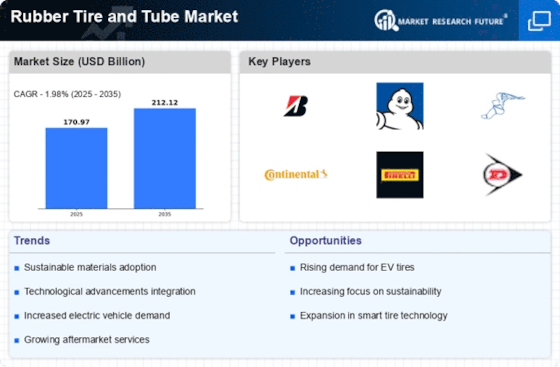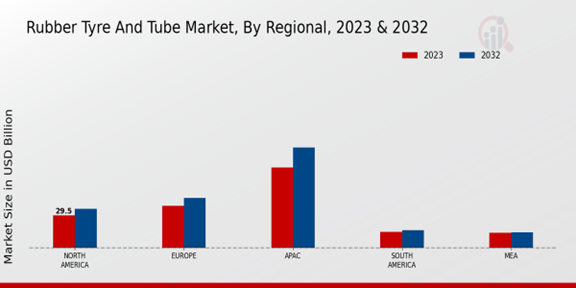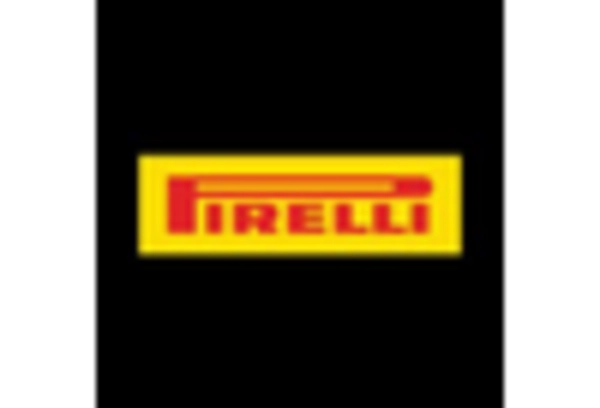Infrastructure Development
Infrastructure development plays a crucial role in propelling the Rubber Tire and Tube Market. Governments and private sectors are investing heavily in road construction and maintenance, which directly influences tire demand. Improved infrastructure facilitates better transportation networks, leading to increased vehicle usage. For instance, the construction of highways and urban roads enhances logistics and freight movement, thereby boosting the need for commercial vehicles and their corresponding tires. The Rubber Tire and Tube Market stands to gain significantly from these developments, as the demand for durable and efficient tires rises in tandem with infrastructure improvements. This trend is likely to continue, as many regions prioritize infrastructure projects to stimulate economic growth.
Increasing Vehicle Production
The rising demand for vehicles is a primary driver for the Rubber Tire and Tube Market. As automotive production ramps up, the need for tires and tubes escalates correspondingly. In recent years, vehicle production has shown a steady increase, with millions of units manufactured annually. This trend is expected to continue, driven by factors such as urbanization and rising disposable incomes. Consequently, the Rubber Tire and Tube Market is poised to benefit from this growth, as manufacturers strive to meet the increasing demand for high-quality tires and tubes. The expansion of electric vehicles also contributes to this demand, as these vehicles require specialized tires, further enhancing the market's potential.
Expansion of E-commerce Platforms
The expansion of e-commerce platforms is significantly impacting the Rubber Tire and Tube Market. As online shopping becomes more prevalent, consumers are increasingly purchasing tires and tubes through digital channels. This shift is facilitated by the convenience of online shopping and the ability to compare products easily. Market data indicates that e-commerce sales in the tire industry are on the rise, with many consumers opting for home delivery services. This trend not only broadens the market reach for manufacturers but also encourages competitive pricing and enhanced customer service. The Rubber Tire and Tube Market is likely to continue evolving in response to these changes, as companies adapt their strategies to leverage the growing e-commerce landscape.
Rising Demand for Sustainable Products
The growing emphasis on sustainability is reshaping the Rubber Tire and Tube Market. Consumers are increasingly seeking eco-friendly products, prompting manufacturers to innovate and develop sustainable tire solutions. This shift is evident in the rising popularity of tires made from renewable materials and those designed for recyclability. Market data indicates that the demand for sustainable tires is projected to grow significantly, as more consumers prioritize environmental considerations in their purchasing decisions. This trend not only aligns with The Rubber Tire and Tube Industry to differentiate themselves through eco-conscious offerings. As regulations around sustainability tighten, the industry is likely to adapt, further driving innovation.
Technological Innovations in Tire Manufacturing
Technological advancements in tire manufacturing are transforming the Rubber Tire and Tube Market. Innovations such as smart tires, which incorporate sensors to monitor tire pressure and performance, are gaining traction. These technologies enhance safety and efficiency, appealing to both consumers and manufacturers. Additionally, advancements in materials science are leading to the development of tires that offer improved durability and performance. Market data suggests that the integration of technology in tire production is expected to drive growth, as consumers increasingly demand high-performance products. The Rubber Tire and Tube Market is likely to see a surge in investment in research and development, as companies strive to stay competitive in an evolving landscape.


















Leave a Comment